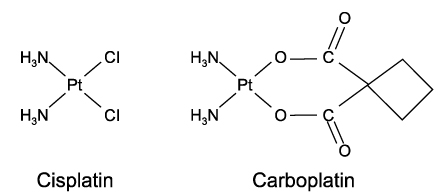J Gynecol Oncol.
2009 Jun;20(2):113-116. 10.3802/jgo.2009.20.2.113.
TRAIL-induced cell death and caspase-8 activation are inhibited by cisplatin but not carboplatin
- Affiliations
-
- 1Department of Obstetrics and Gynecology, Chosun University School of Medicine, Gwangju, Korea. sjhan@chosun.ac.kr
- 2Department of Biochemistry and Molecular Biology, Chosun University School of Medicine, Gwangju, Korea.
- KMID: 2245094
- DOI: http://doi.org/10.3802/jgo.2009.20.2.113
Abstract
OBJECTIVE
Platinum (Pt) based drugs including cisplatin and carboplatin are widely used as anticancer drugs in various human cancers. Many studies have shown that chemotherapeutic agents synergistically enhance cell death induced by death ligands. However it has been recently reported that cisplatin may inhibit tumor necrosis factor-related apoptosis-inducing ligand (TRAIL)-induced cell death through inactivation of caspases. Thus, we investigated whether carboplatin also inhibits TRAIL-induced cell death.
METHODS
HeLa cells were treated with TRAIL in the presence of cisplatin or carboplatin, and cell death was analyzed using the crystal violet staining method. Caspase activation was checked through detection of Bid cleavage by Western blotting using anti-Bid antibody.
RESULTS
Cisplatin inhibits TRAIL-induced cell death in HeLa cells; however, carboplatin enhanced TRAIL-induced cell death. Whereas cisplatin inhibited caspase-8-mediated Bid cleavage, carboplatin had no effect on caspase-8 activity.
CONCLUSION
Although cisplatin and carboplatin are platinum-containing cancer therapeutic agents, they have the opposite effects on TRAIL-induced cell death.
Keyword
MeSH Terms
Figure
Reference
-
1. Rosenberg B, Vancamp L, Krigas T. Inhibition of cell division in escherichia coli by products from a platinum electrode. Nature. 1965. 205:698–699.2. Harrap KR. Preclinical studies identifying carboplatin as a viable cisplatin alternative. Cancer Treat Rev. 1985. 12:Suppl A. 21–33.3. Smith IE, Harland SJ, Robinson BA, Evans BD, Goodhart LC, Calvert AH, et al. Carboplatin: a very active new cisplatin analog in the treatment of small cell lung cancer. Cancer Treat Rep. 1985. 69:43–46.4. Siddik ZH. Cisplatin: mode of cytotoxic action and molecular basis of resistance. Oncogene. 2003. 22:7265–7279.5. Munshi A, McDonnell TJ, Meyn RE. Chemotherapeutic agents enhance TRAIL-induced apoptosis in prostate cancer cells. Cancer Chemother Pharmacol. 2002. 50:46–52.6. Pan G, O'Rourke K, Chinnaiyan AM, Gentz R, Ebner R, Ni J, et al. The receptor for the cytotoxic ligand TRAIL. Science. 1997. 276:111–113.7. Walczak H, Degli-Esposti MA, Johnson RS, Smolak PJ, Waugh JY, Boiani N, et al. TRAIL-R2: a novel apoptosis-mediating receptor for TRAIL. EMBO J. 1997. 16:5386–5397.8. Seol DW, Li J, Seol MH, Park SY, Talanian RV, Billiar TR. Signaling events triggered by tumor necrosis factor-related apoptosis-inducing ligand (TRAIL): caspase-8 is required for TRAIL-induced apoptosis. Cancer Res. 2001. 61:1138–1143.9. Shin JN, Seo YW, Kim M, Park SY, Lee MJ, Lee BR, et al. Cisplatin inactivation of caspases inhibits death ligand-induced cell death in vitro and fulminant liver damage in mice. J Biol Chem. 2005. 280:10509–10515.10. Kim YM, Kim TH, Seol DW, Talanian RV, Billiar TR. Nitric oxide suppression of apoptosis occurs in association with an inhibition of Bcl-2 cleavage and cytochrome c release. J Biol Chem. 1998. 273:31437–31441.11. Ivanov AI, Christodoulou J, Parkinson JA, Barnham KJ, Tucker A, Woodrow J, et al. Cisplatin binding sites on human albumin. J Biol Chem. 1998. 273:14721–14730.12. Mandal R, Kalke R, Li XF. Interaction of oxaliplatin, cisplatin, and carboplatin with hemoglobin and the resulting release of a heme group. Chem Res Toxicol. 2004. 17:1391–1397.13. Dedon PC, Borch RF. Characterization of the reactions of platinum antitumor agents with biologic and nonbiologic sulfur-containing nucleophiles. Biochem Pharmacol. 1987. 36:1955–1964.
- Full Text Links
- Actions
-
Cited
- CITED
-
- Close
- Share
- Similar articles
-
- The Study of the Cytotoxic Mechanism of Cisplatin in HeLa Cells
- Control of Mitochondrial Dynamics by Fas-induced Caspase-8 Activation in Hippocampal Neurons
- Human hepatocellular carcinoma cells resist to TRAIL-induced apoptosis, and the resistance is abolished by cisplatin
- A Comparative Study of the Toxicity Between carboplatin and Cisplatin in VBP Combination Chemotherapy
- Cytotoxic Effects of Tumor Necrosis Factor-related Apoptosis-inducing Ligand (TRAIL)and its Molecular Mechanism in Human Gastric Cancer Cells




